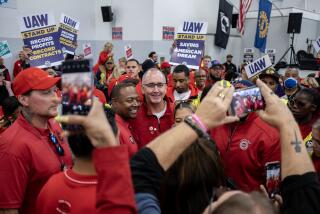Others Stand to Gain From Cat Fight
The odds are that Caterpillar Inc.’s immoral threat to devastate the lives of its 13,000 striking workers, their families and their communities will fail. But the bitterness provoked by the company’s tactics could make a quick settlement difficult.
After more than five months of complete stalemate, the company and the United Auto Workers agreed last Friday to resume negotiations at the invitation of Bernard DeLury, head of the Federal Mediation Service.
Cat could still win the all-out war it has declared against its employees and their union if it can hire enough “permanent replacements” to resume production without the experienced strikers.
There are tens of thousands of job-hungry workers ready to move in. But Cat has to find enough of them to do the highly skilled work or be able to train unskilled people soon enough to make the strike’s costs worth it to the company.
The company moguls hoped the threat of being permanently replaced would start a stampede of UAW members across their own picket lines and break the five-month strike. That would encourage other corporations to go and do likewise.
But that isn’t happening, and industry experts say Cat is having a hard time getting enough trainable strikebreakers.
Permanently replacing workers, or trying to, isn’t new. But it has never been tried by a major manufacturing company on such a large scale. Former President Ronald Reagan started a trend when he permanently fired thousands of air-traffic controllers for striking in 1981.
Cat may back down if there are no major defections from the strikers’ ranks and strikebreakers cannot maintain the production standards that have given the company its excellent worldwide reputation for the quality of its products.
But the tactic itself is so explosive and dangerous to companies and workers alike that the House has already passed a workplace fairness bill to outlaw it. The sufferings of both Cat workers and the company caused by the tactic may help push it through the Senate.
While the anti-union President Bush, friend of corporate America, says he will veto it, passage by Congress might deter corporate copycats a bit. If the political tides change in November, it could become law next year.
That would make sense since workers do have the legal right to strike without being fired for exercising that right--but oxymoronically, they can be permanently replaced, which is still legal, even though it is the same as being fired.
There has been labor strife at Cat in the past, but this is the first time in the 45-year history of the UAW contract with the company that the rulers of the multibillion-dollar corporation are trying to recruit permanent replacements.
That means if the company succeeds, the strikers--who have been employed there for an average of 23 years--will be out looking for jobs in communities already hard hit by unemployment. An alternative would be for a negotiated settlement, but that would mean the company would have to go back on its word and fire the “scabs.”
The productivity of Cat’s workers is impressive. Last year, they produced as much as they did in 1979, but with 60% fewer workers as a result of extensive factory modernization and the cooperation of the workers.
The basic issue in the dispute is Cat’s demand for an end to pattern bargaining, which began in 1958 in the heavy equipment industry and is used in other industries too. Under pattern bargaining, workers in the same industry under the same union contracts are paid essentially the same.
Pattern bargaining makes sense in a decent society because it is based on the theory that companies should not compete with one another by seeing which one can force employees to work for the lowest wages and fringe benefits.
America didn’t attain its greatness by paying wages that are competitive with low-wage developing countries. European workers already earn more than Americans. Competition should be based on productivity, quality and innovation of managers and workers, not on wage cuts.
Cat says it wants a labor-cost advantage over its competitors because it is now in global competition. How is that new for a multinational corporation that in 1958 began a joint venture with a Japanese giant to create Shin Cat Mitsubishi, which pays its workers almost the identical amount Cat workers get here?
The United States is the only major industrialized nation in the world that allows employers to permanently replace strikers.
Cat’s executives taunt its workers here by talking ominously about the low wages they pay workers in developing countries like Brazil and Mexico.
The company tried to extract a labor-cost advantage over its competitors in 1982. It didn’t use “permanent replacements” then. It took a whopping 205 days to settle that dispute, but when it was over, pattern bargaining continued and peace reigned for almost a decade until the current strike began last November.
John Deere & Co. set what was expected to be a pattern for the heavy equipment industry last year, retaining company-paid medical benefits, seniority rights and boosting wages by about 13% over three years. Cat decided once again to take on a costly battle to avoid the pattern that Deere’s President David Stowe said was “fair, balanced and equitable for both sides.”
The differences between Cat’s last offer and the Deere contract are not great, but the principle certainly is for the union.
If it surrenders pattern bargaining entirely, other industries, like automobiles, will want to do the same. In time, competition may well be based partly--maybe primarily--on which company can pay the lowest wages and benefits, thereby further eroding the living standards of the middle class.
The fight at Cat could serve one good purpose for the country, however. It could give new impetus for passage of the workplace fairness bill that would ban the permanent replacement of workers in legal strikes.
More to Read
Inside the business of entertainment
The Wide Shot brings you news, analysis and insights on everything from streaming wars to production — and what it all means for the future.
You may occasionally receive promotional content from the Los Angeles Times.










